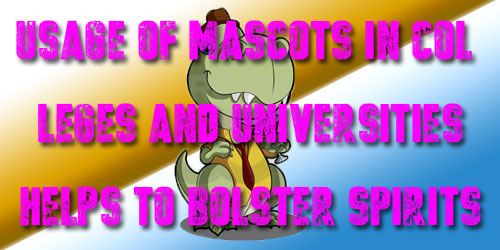 18 July 19
18 July 19
Usage Of Mascots In Colleges And Universities Helps To Bolster Spirits
Mascots on College or university and School Campuses
Dating back for the 1800's the usage of mascots in colleges and universities has aided to foster satisfaction and improve the spirit of enthusiasts. At the earliest incarnation, mascots used on college and college campuses for athletics were largely live animals. It has become a custom and some campuses still training this even today. Mascots for hundreds possibly thousands of decades have been seen as icons of luck. This is why some college or university and universities will still draw out a live pet onto the industry as a mascot to get the crowd included. Animals such as: lions, tigers, buffaloes, and bulldogs have already been used as live life mascots to mention a few. The Colorado Buffaloes will most likely bring a buffalo out onto their house field during half-time. Boosters at most campuses provide you with the necessary funds for the feeding and maintenance of live mascots.
Usage of Live Mascots a Controversy for Colleges and Universities
However, the use of live creatures as Mascot Logo Design Company on university and university or college campuses has been fraught with controversy. Persons for your Ethical Remedy of Wildlife (PETA) has had much to state about the usage of creatures as mascots over the years. Many people inside the group feel that it is unethical and perhaps unhealthy to keep animals in captivity for the sole purpose of being a mascot. Their concern arises amid some creature mascots dying like a tiger from renal disappointment. PETA argues how the cages that this animals are held in are barely large enough to permit for free activity. Also, sometimes temperatures can be extreme and possessing thousands of fans in one spot near the creature can cause it distress. Competitor schools will sometimes take the mascot of some other schools. This is a continuing controversy that hasn't come to a clean ending. Some colleges and universities view using live canine mascots as an extended standing tradition that's harmless. Animal rights activists feel it is inhumane and unethical and needs to end.
Countless Mascots Resemble Those in Professional Sports
Several universites and colleges don't use live mascots. Their mascots are very similar to the ones witnessed at professional soccer, soccer, and golf ball games. Somebody wears a go well with and gets to be the personality for any team. Plenty of intense training can go into becoming a mascot for just a college or university. The person has to have a high degree of energy, be enthusiastic and engaging, have the ability to supply the mascot "personality," and embrace gestures befitting a mascot. Many will know dances, mime, perform skits, waves flags together with the crowds, or hold up signs to get the crowd engaged. It is fairly the acting task and requirements that the individual performing because the mascot maintain consistent, upbeat, and good behavior. It's not only important for the mascot to connect to other university students. A mascot needs to be accessible to all or any college and college or university fans such as for example alumni, local community, faculty, and kids of fans.
College and College or university Mascots aren't Generally Stereotypical
The use of mascots in universites and colleges do not always slip along stereotypical lines. Mascots are often patterned for qualities of the school or the students attending the schools. The boll weevil has become used in college sports because the mascot for that University of Arkansas at Monticello. Some would argue that it generally does not appear to be a formidable foe. However, it is one of the biggest detriments to organic cotton crops within the U.S.
The Arguing Okra is the mascot representing Delta State. Fans from the school's team were opposed to utilizing the vegetable because they didn't think it portrayed the proper graphic. Some argued that it was mean, alternative, and indigenous to the Southern region of America. With all this reasoning the mascot name has stuck.
The College of Hawaii-Hilo has had a different approach with their Mascot Logo Design Agency. They have emulated the Vulcans of Legend Trek admirer and produced them their mascot. Their reasoning is because of the massive amount volcanic action through the islands, the name meets perfectly.


Comments